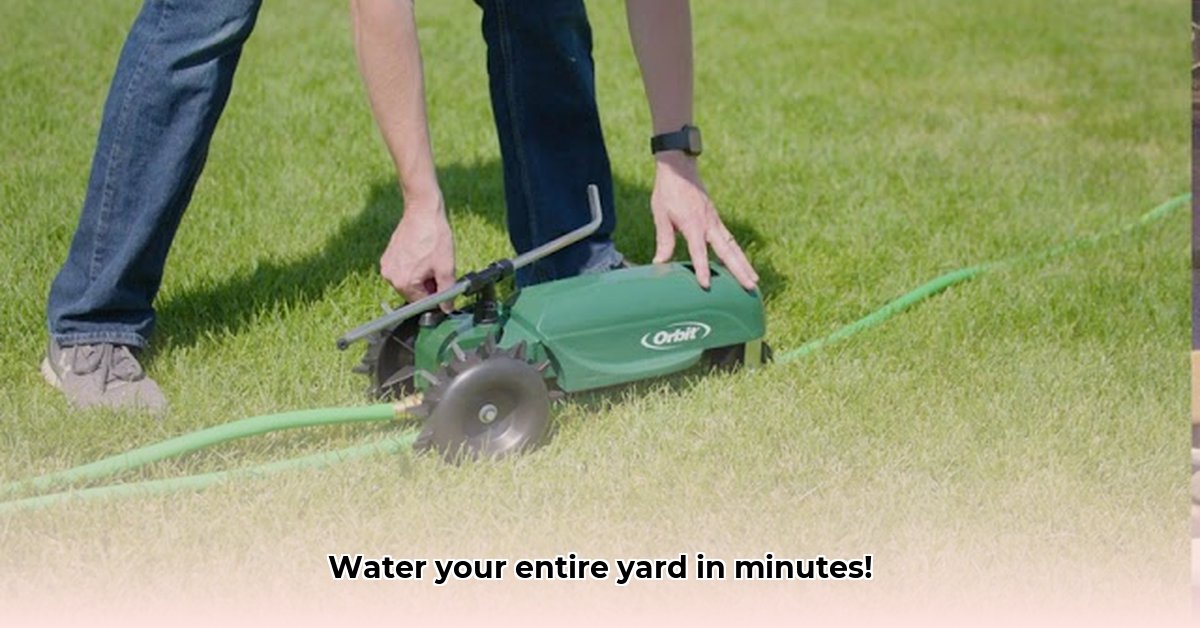
Lawn Watering Tractor Alternatives: A Deep Dive into the Orbit Traveling Sprinkler
For homeowners with expansive lawns, the chore of watering can feel endless. Dragging hoses and adjusting sprinklers consumes valuable time and energy. The Orbit Traveling Sprinkler promises a solution: self-propelled irrigation covering up to 13,500 square feet. But does it deliver on its ambitious claims? This comprehensive review delves into the Orbit's features, performance, and value, comparing it to competitors and examining real-world user experiences. We'll determine if this innovative sprinkler is a worthwhile investment or a potential headache.
Key Features and Specifications: Unveiling the Orbit's Capabilities
The Orbit Traveling Sprinkler utilizes water pressure for propulsion, eliminating the need for external power sources. This self-propelled design is its standout feature. While the manufacturer emphasizes a primarily cast iron construction (suggesting durability), the exact material composition remains unclear, potentially impacting longevity. The adjustable spray radius, ranging from 15 to 55 feet, offers adaptability to diverse lawn sizes and shapes. Three speed settings (high, low, and neutral) allow for customized watering patterns and water conservation. An automatic shutoff feature prevents overwatering, safeguarding your lawn and water resources. But how accurately does it achieve its advertised coverage?
| Feature | Specification | Notes |
|---|---|---|
| Propulsion | Water-powered, self-propelled | Eliminates the need for external power sources. |
| Spray Radius | Adjustable, 15-55 feet | Allows for customized coverage based on lawn size and shape. |
| Speed Settings | High, Low, Neutral | Enables precise control over watering speed and water usage. |
| Material | Primarily cast iron (exact composition unclear) | Impacts long-term durability and resistance to environmental factors. |
| Automatic Shutoff | Yes | Prevents overwatering and conserves water. |
| Claimed Coverage | Up to 13,500 sq ft (variable reporting) | Actual coverage significantly varies depending on factors discussed below. |
Coverage Area: Reality Check on Advertised Performance
A significant discrepancy exists in reported coverage areas. While some sources advertise up to 13,500 square feet with a 200-foot hose, other accounts suggest much lower figures. This inconsistency raises concerns and underscores the importance of realistic expectations. Factors such as water pressure, lawn slope, soil type, and even hose kinks significantly influence the sprinkler's actual reach. The maximum claimed coverage likely represents ideal conditions rarely encountered in real-world applications. Is the advertised 13,500 square foot coverage achievable in most scenarios? The answer, unfortunately, is likely no.
Performance Analysis: Real-World Testing and Limitations
The Orbit's performance is optimal on level lawns with consistent, high water pressure. Uneven terrain significantly hinders its movement and results in irregular water distribution, leaving some areas dry. Low water pressure further compounds this issue, slowing its progress and reducing coverage. Users in areas with fluctuating water pressure might find it unreliable. These factors highlight the need for careful consideration before purchasing and suggest it might be underperforming, even on average-sized lawns.
Comparative Analysis: Weighing the Orbit Against Competitors
While the Orbit's self-propelled design offers convenience, its inconsistent coverage claims set it apart from competitors. Many other automatic sprinkler systems offer more predictable coverage and potentially better water efficiency, though they may require more manual adjustment. Direct comparisons with models featuring similar price points and coverage areas are crucial before making a purchasing decision. A side-by-side examination of features, durability, and user reviews would offer a clearer picture of the Orbit's competitive position.
Pros and Cons: A Balanced Assessment of the Orbit Sprinkler
Pros:
- Self-propelled design for convenient, hands-free operation.
- Adjustable spray radius for customizable coverage.
- Automatic shutoff to prevent water waste and lawn damage.
Cons:
- Inconsistent coverage claims raise significant concerns about real-world performance.
- Performance significantly impacted by uneven terrain and low water pressure.
- Uncertainty regarding long-term durability due to unspecified material composition.
User Reviews and Feedback: Hearing from Actual Users
Online reviews reveal a mixed bag of experiences. While some users praise the Orbit’s ease of use and time savings, many express concerns about inconsistent watering patterns and mechanical issues. These reports underscore the need for diligent maintenance and highlight potential reliability problems. These reviews suggest a need for improved design and manufacturing to address reported defects.
Maintenance and Durability: Ensuring a Long Lifespan
Regular maintenance, including cleaning nozzles and inspecting moving parts, is essential to extend the Orbit’s lifespan. The uncertain material composition makes predicting long-term durability difficult. Proactive maintenance can mitigate some potential issues, but the inherent design vulnerabilities need to be considered.
Value for Money: Is it Worth the Investment?
The Orbit's value is debatable due to the inconsistency in reported performance and the potential for maintenance issues. The convenience of self-propelled operation comes at the risk of unpredictable watering and possible repairs. The cost-benefit analysis depends heavily on your specific needs and resources. Is the time saved equivalent to the potential financial investment in repairs or replacement?
Conclusion: A Cautious Recommendation
The Orbit Traveling Sprinkler offers a unique approach to lawn watering, but its performance inconsistencies and uncertain durability raise concerns. While its self-propelled design is appealing, potential buyers should carefully weigh the advantages against the potential drawbacks. For those with perfectly level lawns and consistently high water pressure, it might prove worthwhile. However, for those with uneven terrain or unreliable water pressure, it’s likely to fall short of expectations. Thorough research and realistic expectations are crucial before making a purchase.